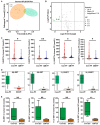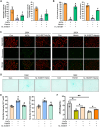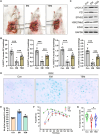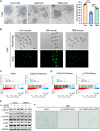EETs Reduction Contributes to Granulosa Cell Senescence and Endometriosis-Associated Infertility via the PI3K/AKT/mTOR Signaling Pathway
- PMID: 40827571
- PMCID: PMC12622488
- DOI: 10.1002/advs.202505656
EETs Reduction Contributes to Granulosa Cell Senescence and Endometriosis-Associated Infertility via the PI3K/AKT/mTOR Signaling Pathway
Abstract
We aimed to examine abnormal oxidative lipid levels and their related mechanisms in EM-associated infertility. Through liquid chromatography tandem mass spectrometry analysis, decreased levels of epoxyeicosatrienoic acids (EETs), which have antioxidant and anti-senescence effects are observed, in EM patient follicular fluid samples. EET levels are positively correlated with in vitro fertilization outcomes. Lower 14, 15-EET concentrations led to a decreased GC antioxidant capacity, reduced ATP production, reactive oxygen species (ROS) accumulation in oocytes, and abnormal cumulus-oocyte complex (COC) expansion, ultimately resulting in decreased fertility. Elevated soluble epoxide hydrolase (EPHX2) expression in EM-GCs is the main reason for EET reduction in EM follicular fluid. Inhibiting EPHX2 in vivo or in vitro can reverse these observed abnormalities by upregulating EETs. 14, 15-EET treatment alleviated GC senescence and improved fertility by inhibiting excessive PI3K/AKT/mTOR signaling pathway activation in EM-GCs, with BEZ-235-mediated inhibition of this pathway significantly alleviating ROS-induced cell senescence and abnormal COC expansion. Oxidative stress-induced decreased EZH2/H3K27Me3 histone methylation led to elevated EPHX2 expression patterns in EM-GCs. Decreased 14, 15-EET levels resulted in ROS accumulation, reduced EZH2 enzymatic activity, less EPHX2/H3K27Me3 histone methylation, and increased EPHX2 protein expression levels, which further reduced 14, 15-EET levels in a vicious feedback loop.
Keywords: 14, 15‐EET; EPHX2; EZH2/H3K27Me3; PI3K/AKT/mTOR signaling pathway; ROS; cellular senescence; endometriosis; ovary granulosa cell.
© 2025 The Author(s). Advanced Science published by Wiley‐VCH GmbH.
Conflict of interest statement
The authors declare no conflict of interest.
Figures










References
-
- Tanbo T., Fedorcsak P., Acta. Obstet. Gyn. Scan. 2017, 96, 659. - PubMed
-
- Leone Roberti Maggiore U., Chiappa V., Ceccaroni M., Roviglione G., Savelli L., Ferrero S., Raspagliesi F., Spano Bascio L., Best Pract. Res. Clin. Obstet. Gynaecol. 2024, 92, 102454. - PubMed
-
- de Ziegler D., Borghese B., Chapron C., Lancet 2010, 376, 730. - PubMed
MeSH terms
Substances
Grants and funding
LinkOut - more resources
Full Text Sources
Medical
Miscellaneous
